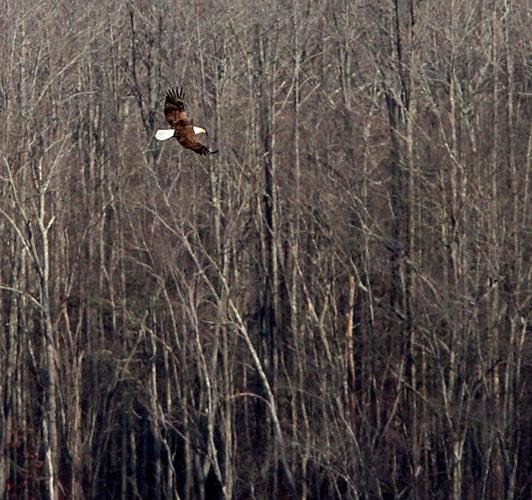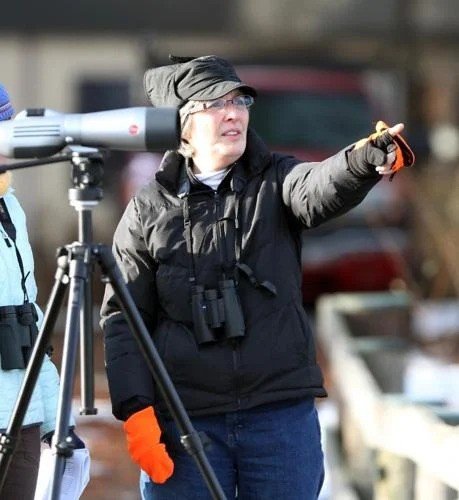Bald eagles making comeback in New Jersey
I published this article in 2011 for The Press of Atlantic City. It was also picked up by The Associated Press to be published nationwide. See the original story on PressofAtlanticCity.com. (Photos by Dale Gerhard.)
MILLVILLE - Jane Galetto gently stepped onto her frozen dock by a bend in the Maurice River, binoculars around her neck, a telescope positioned ahead of her and a bald eagle dunking its talons in the distant water looking for fish.
Galetto's Brittany Lane home is a perfect vantage point for observing the rebound of New Jersey's eagles, which reached a record population of 333 birds and 82 eagle pairs actively laying eggs last year, according to an annual report released by the state earlier this month.
That's a dramatic increase from 30 years ago, when only one nest remained in the state - with New Jersey's population of eagles nearly wiped out by habitat loss, human disturbance and the widespread use of the pesticide DDT.
By incubating eggs and introducing birds from outside the area, including Canada, state conservationists and dozens of volunteers have brought New Jersey's eagles back from the brink.
Jane Galetto
The eagles are widespread along the Delaware Bay and are scattered in Cape May, Atlantic and southeastern Burlington counties, with at least one nest in every county but three in northern New Jersey. The species was taken off the nation's list of endangered species in 2007, and even though they remain endangered in the state, people who have followed the eagle's return say their resurgence shows no signs of stopping soon.
"Wait until you see this year," said Peter Dunne, chief communications officer for the New Jersey Audubon Society's Center for Research and Education. "It's almost exponential at this point."
"It's a rare day when I don't pass four bald eagles on my way to work," said Dunne, who drives every morning from his home in Commercial Township to his office in Middle Township. "And I'm not even looking. I used to spend whole weekends looking for an eagle."
Galetto tells a similar story. She moved to her southern corner of Millville in the early 1980s, when the lone eagle nest in the state sat in the Bear Swamp section of Downe Township.
Now there's a massive nest built this fall, 150 yards across the water from her home - and another up the river that she regularly observes through a spotting scope.
On a recent morning with a freezing northwest wind blowing down the river, Galetto joined Larissa Smith, a biologist with the Conserve Wildlife Foundation of New Jersey, as they watched a half-dozen bald eagles from her dock. Smith is a volunteer manager for the New Jersey Bald Eagle Project, which counts 25 volunteers in Cumberland, Cape May, Atlantic and Burlington counties who monitor nests year-round and relay information back to state biologists.
Those biologists also climb the tall trees where eagles prefer to assemble their nests, measuring young eaglets, taking blood samples to measure for contaminants and attaching bands to their legs in order to monitor them later.
Earlier this month, 75 volunteers took part in the midwinter eagle survey and found 235 eagles statewide, 194 of which were in southern New Jersey. Smith blamed the diminished number on low visibility from a snow storm the weekend the count took place.
Because of the still-high numbers in these counts, the state proposed on Friday to change the conservation status of nonbreeding eagles, such as juveniles and eagles that winter in New Jersey, to threatened rather than endangered.
Galetto, who is also a conservationist and former chair of local organization Citizens United to Protect the Maurice River and its Tributaries, is one of the volunteers Smith regularly communicates with, monitoring the eagles on her piece of the river.
"They watch me as much as I watch them," Galetto said about the eagles who occasionally perch high up in her trees and peer down at her while she walks her dogs.
The most she's ever seen at once from her property, she said, was 13.
On this brisk morning, the birds rested on platforms left empty while their usual osprey occupants winter in South America. Occasionally they would lift themselves into the sky with their massive wings, alighting on the tallest trees on the river banks.
The recovery of ospreys is another success story for conservationists, but eagles are an almost mythical species that whole generations of southern New Jersey residents have grown up unaware of as an element of local wildlife. Now those people gawk when they see them soaring overhead on the beach or along the Mullica River.
"Birds of prey in general are hot button birds," said Dunne. "But when it comes to a popularity contest, the bird that is your national emblem is going to win."
That being true, Smith cautioned that people should still try to contain their enthusiasm for eagles and keep their distance. They are private and elusive birds, and coming too close to their nests to snap photos can scare them away and cause them to abandon their eggs.
That kind of disturbance remains an issue affecting eagle populations, as does the loss of habitat. Eagles prefer a particular kind of home, choosing secluded trees that stand high above others to provide easy access and a lookout for prey, but human development has limited such locations.
And despite the record number of birds recorded last year, those egg-laying birds had the lowest productivity rate in 17 years, which biologists attribute to heavy rain and snow as well as several wind storms that wrecked nests.
The state's statistics are limited by a lack of historical data. By the time comprehensive studies were first attempted, eagle population numbers were likely already diminished by human influences - from land clearing to poisoning to farmers shooting the birds to protect young small livestock.
That means scientists also are not sure how much of a local population the environment here can sustain, but they also believe that the bigger it is, the better it is.
"Eagles are bellwethers," said Dunne, since they perch at the top of the food pyramid. "If eagle populations are healthy, it speaks well for environment at large."


